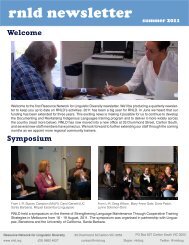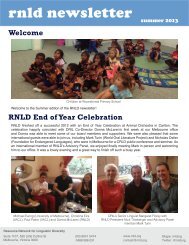The ethnography of language and language ... - Linguistics
The ethnography of language and language ... - Linguistics
The ethnography of language and language ... - Linguistics
Create successful ePaper yourself
Turn your PDF publications into a flip-book with our unique Google optimized e-Paper software.
114 Jane H. Hill<br />
most dynamic <strong>of</strong> local systems, where goals <strong>and</strong> routines are negotiated at<br />
the level <strong>of</strong> distinct individuals.<br />
<strong>The</strong> last requirement is attention to <strong>language</strong> ideology. One <strong>of</strong> the reasons<br />
history speeds up at the margins is that oppression <strong>and</strong> marginalization –<br />
<strong>and</strong> minority <strong>and</strong> indigenous <strong>language</strong> communities are almost by definition<br />
oppressed <strong>and</strong> marginalized – produces a special intensification <strong>of</strong> <strong>language</strong>ideological<br />
projects. <strong>The</strong>se can silence the voices <strong>of</strong> speakers, render untenable<br />
the presence <strong>of</strong> a researcher, or impede the distribution <strong>and</strong> implementation<br />
<strong>of</strong> the products <strong>of</strong> research, even within the community. Recent<br />
advances in our underst<strong>and</strong>ing <strong>of</strong> the semiotics <strong>of</strong> <strong>language</strong> ideologies provide<br />
very useful tools for documentary linguists, who must be able not only<br />
to identify <strong>and</strong> work among clashing ideological discourses, but assist<br />
communities with what Nora <strong>and</strong> Richard Dauenhauer (1998) have called<br />
“ideological clarification” to bring these discourses into line with what a<br />
community truly desires for endangered-<strong>language</strong> resources.<br />
1. <strong>The</strong> <strong>ethnography</strong> <strong>of</strong> <strong>language</strong>:<br />
Relativity <strong>and</strong> the organization <strong>of</strong> diversity<br />
Most linguists attend almost exclusively to what Michael Silverstein (1979<br />
<strong>and</strong> elsewhere) calls “denotational text.” We can state the formal properties<br />
<strong>of</strong> declarative vs. interrogative vs. imperative sentences, for instance, without<br />
really paying much attention to the well-known fact that both assertions<br />
<strong>and</strong> questions can function as comm<strong>and</strong>s, or that comm<strong>and</strong>s can be made<br />
only under certain social conditions. But documentary linguistics on <strong>language</strong>s<br />
that are no longer taken for granted, where every construction carries<br />
a heavy political burden, really does not permit us the luxury <strong>of</strong> this<br />
particular reduction. We can find practical help in some <strong>of</strong> the foundational<br />
principles <strong>of</strong> the <strong>ethnography</strong>-<strong>of</strong>-<strong>language</strong> tradition.<br />
<strong>The</strong> first <strong>of</strong> these principles is that speech communities will differ not<br />
only in manifesting different kinds <strong>of</strong> <strong>language</strong> structures, but in manifesting<br />
different patterns <strong>of</strong> use. An <strong>ethnography</strong> <strong>of</strong> the distribution <strong>of</strong> registers,<br />
speech-act types, <strong>and</strong> the like across the contextual l<strong>and</strong>scape is critical to<br />
linguistic documentation. For instance, certain kinds <strong>of</strong> syntactic constructions<br />
may occur only in certain registers, so that even basic elicitation strategies<br />
will require ethnographic preparation. Hymes’ well-known SPEAKING<br />
heuristic provides a rule <strong>of</strong> thumb to help us notice patterns <strong>of</strong> usage. <strong>The</strong><br />
acronym “SPEAKING” abbreviates some <strong>of</strong> the major components <strong>of</strong> the





